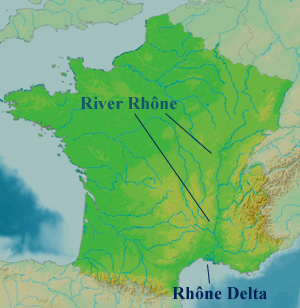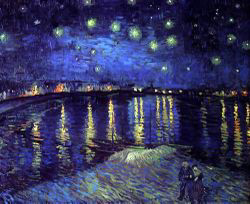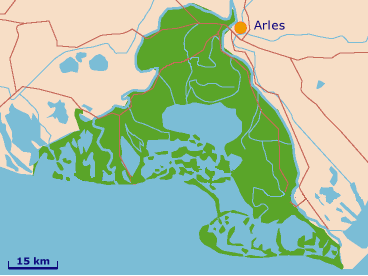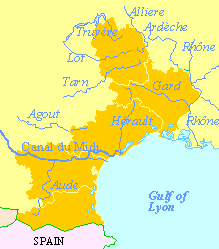

The river rises near the Rhône Glacier in Valais, Switzerland, in the Saint-Gotthard massif, at an altitude of 1753 meters. Up to Martigny, it is a torrent; it then becomes a large mountain river running Southwest through a glacier valley. It turns Northwest to leave the Alps and then flows west through Lake Geneva before entering France.

![]() At
Arles the Rhône divides into two arms with all branches
flowing into the Mediterranean
Sea. One arm is called the "Grand Rhône",
the other one is the "Petit Rhône". Between
them and the sea is the river delta, known as the
Camargue, home to a unique range of wildlife including
Camargue Bulls and
Camargue Horses
At
Arles the Rhône divides into two arms with all branches
flowing into the Mediterranean
Sea. One arm is called the "Grand Rhône",
the other one is the "Petit Rhône". Between
them and the sea is the river delta, known as the
Camargue, home to a unique range of wildlife including
Camargue Bulls and
Camargue Horses

![]() The
Rhône is an important route for inland navigation, connecting the industrial
cities of Arles, Avignon, Valence, Vienne and Lyon to the Mediterranean Sea ports
of Fos, Marseille and Sète. The Rhône is developed as a class V waterway
from the mouth of the Saône to the sea. The Saône river, which is
also canalized, connects the Rhône ports to the cities of Villefranche,
Macon and Chalons. Smaller vessels (up to CEMT class I) can travel further North-West,
North and North-East via the Centre-Loire-Briare and Loing Canals to the Seine
river, via the Canal de la Marne à la Saône (often called the "Canal
entre Champagne et Bourgogne") to the Marne, via the Canal des Vosges (formerly
the "Canal de l'Est - Branche Sud" to the Moselle and via the Canal
du Rhône au Rhin to the Rhine.
The
Rhône is an important route for inland navigation, connecting the industrial
cities of Arles, Avignon, Valence, Vienne and Lyon to the Mediterranean Sea ports
of Fos, Marseille and Sète. The Rhône is developed as a class V waterway
from the mouth of the Saône to the sea. The Saône river, which is
also canalized, connects the Rhône ports to the cities of Villefranche,
Macon and Chalons. Smaller vessels (up to CEMT class I) can travel further North-West,
North and North-East via the Centre-Loire-Briare and Loing Canals to the Seine
river, via the Canal de la Marne à la Saône (often called the "Canal
entre Champagne et Bourgogne") to the Marne, via the Canal des Vosges (formerly
the "Canal de l'Est - Branche Sud" to the Moselle and via the Canal
du Rhône au Rhin to the Rhine.
The Rhône valley is responsible for funneling the famous Mistral wind into the Camargue and Provence. Lesser winds traveling the same route and drying any precipitation are responsible for the conditions favourable to wine making. It was also down this great river valley that the French swept in 1208 to wreak havoc on the people of the Languedoc and persecute the Cathars, and later to create the Inquisition and to annex the Languedoc to France.
 Ròse, Provençal Roun)
Ròse, Provençal Roun)






